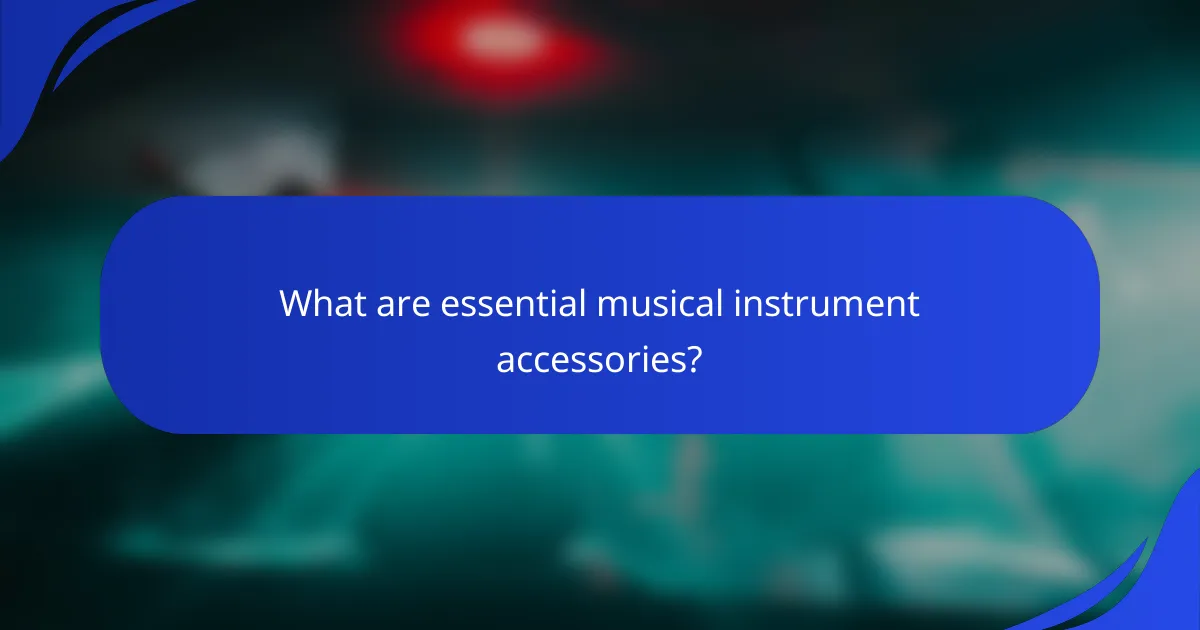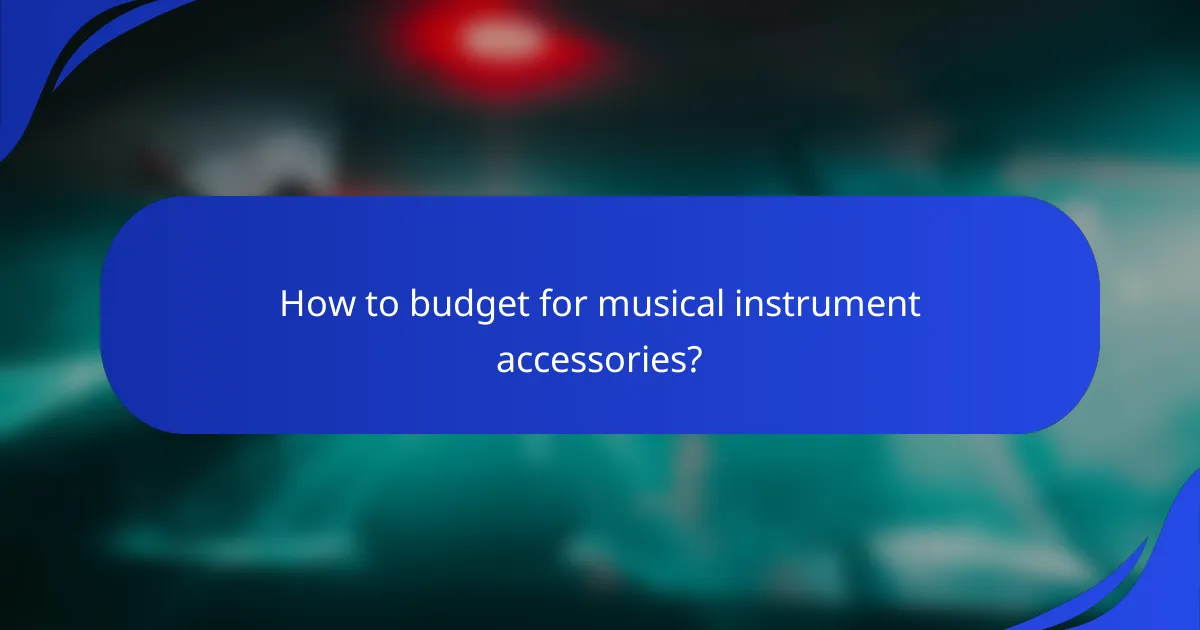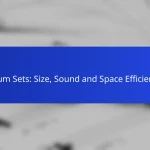Musical instrument accessories play a crucial role in enhancing performance and maintaining the quality of your instruments. From cleaning supplies to replacement parts, these essential items ensure that your instrument functions optimally and sounds its best. Budgeting for these accessories involves assessing your needs and prioritizing purchases to make the most of your investment without overspending.

What are essential musical instrument accessories?
Essential musical instrument accessories are items that enhance the performance and maintenance of instruments. They include various tools and components that musicians need to ensure their instruments function optimally and sound their best.
Strings for guitars and violins
Strings are crucial for guitars and violins, as they directly affect sound quality and playability. Guitar strings typically come in different materials like nickel, bronze, or nylon, while violin strings are often made from gut, synthetic, or steel. Choosing the right type can influence tone and durability.
When selecting strings, consider factors such as gauge (thickness) and material, which can range from light to heavy. Regularly changing strings is essential, as worn strings can lead to poor sound and tuning issues.
Reeds for woodwind instruments
Reeds are vital for woodwind instruments like clarinets and saxophones, as they produce sound by vibrating when air passes through. Reeds come in various strengths and materials, affecting tone and response. Beginners may prefer softer reeds, while advanced players might choose harder ones for more control.
It’s important to regularly replace reeds, as they can wear out quickly. A good practice is to have several reeds on hand to ensure consistent performance during practice or performances.
Drumsticks for percussion
Drumsticks are essential for percussion instruments, providing the means to strike drums and cymbals. They come in various sizes, weights, and materials, such as wood or nylon, which can affect sound and feel. Choosing the right drumstick can enhance your playing experience and sound quality.
Consider the type of music you play when selecting drumsticks. For example, lighter sticks are often preferred for jazz, while heavier sticks may be better suited for rock. Regularly check for wear and replace them as needed to maintain optimal performance.
Capos for guitars
Capos are devices used on guitars to change the pitch of the strings, allowing musicians to play in different keys without changing finger positions. They are particularly useful for singer-songwriters who want to match their vocal range. Capos come in various styles, including spring-loaded and trigger types.
When using a capo, ensure it is placed correctly to avoid buzzing or muted strings. Experiment with different positions to find the best sound for your music. Having a capo handy can expand your playing options significantly.
Microphones for amplifying sound
Microphones are essential for amplifying sound from instruments, especially in live performances or recordings. Different types of microphones, such as dynamic and condenser, serve various purposes and environments. Dynamic mics are often used for live settings, while condenser mics are preferred for studio recordings due to their sensitivity.
When selecting a microphone, consider factors like pickup pattern and frequency response. Investing in a quality microphone can greatly enhance your sound, so it’s worth researching options that fit your budget and needs. Always test microphones in your specific setting to ensure the best results.

How to budget for musical instrument accessories?
Budgeting for musical instrument accessories involves identifying your needs, setting a financial plan, and prioritizing essential items. This approach ensures you invest wisely in accessories that enhance your playing experience without overspending.
Assessing your instrument needs
Begin by evaluating the specific accessories required for your instrument. For example, a guitarist may need picks, strings, and a tuner, while a pianist might prioritize a bench and a sustain pedal. Consider your playing style and frequency of use to determine what is truly necessary.
Make a list of accessories that will improve your performance or maintenance. This could include items like cases, stands, or cleaning supplies. Understanding your instrument’s requirements helps you focus on what will provide the most value.
Setting a monthly budget
Establish a monthly budget for accessories based on your overall financial situation. A reasonable starting point could be allocating around 5-10% of your income towards musical expenses. Adjust this percentage according to your priorities and other financial commitments.
Track your spending to ensure you stay within your budget. Use a simple spreadsheet or budgeting app to monitor expenses related to accessories. This practice will help you identify areas where you can save or adjust your spending habits.
Prioritizing essential items
Once you have assessed your needs and set a budget, prioritize your purchases. Focus on essential items first, such as strings or cleaning kits, before considering luxury accessories like custom cases or decorative items. This ensures that your immediate needs are met without overspending.
Consider creating a tiered list of accessories based on necessity. For example, categorize items into ‘must-have’, ‘nice-to-have’, and ‘optional’. This method helps you make informed decisions when allocating your budget and prevents impulse buys.

What are the best brands for musical instrument accessories?
Some of the best brands for musical instrument accessories include D’Addario, Vandoren, Vic Firth, and Shure. These companies are recognized for their quality and reliability, making them top choices for musicians seeking essential accessories.
D’Addario for strings
D’Addario is widely regarded as a leading brand for instrument strings, offering a variety of options for guitars, violins, and other string instruments. Their products are known for durability and consistent performance, catering to both beginners and professional musicians.
When selecting D’Addario strings, consider the material and gauge that best suits your playing style. For example, lighter gauges are easier to play but may produce a different tone compared to heavier strings. Regularly changing strings can significantly enhance sound quality.
Vandoren for reeds
Vandoren is a premier choice for woodwind players, particularly for clarinet and saxophone reeds. Their reeds are crafted with precision, offering various strengths to accommodate different playing styles and preferences.
Choosing the right Vandoren reed strength is crucial; beginners might start with softer reeds for easier playability, while advanced players often prefer harder reeds for more control and projection. It’s advisable to experiment with different strengths to find the best fit for your instrument and technique.
Vic Firth for drumsticks
Vic Firth is synonymous with high-quality drumsticks, providing a wide range of models tailored to different genres and playing techniques. Their sticks are made from hickory or maple, each offering unique characteristics in terms of weight and feel.
When selecting Vic Firth drumsticks, consider the length and thickness that suit your playing style. For instance, thicker sticks provide more power, while thinner sticks allow for greater speed and finesse. Regularly checking for wear and tear can help maintain optimal performance.
Shure for microphones
Shure is a trusted name in microphones, known for their durability and sound quality across various applications, from live performances to studio recordings. Their microphones cater to vocalists and instrumentalists alike, ensuring clarity and reliability.
When choosing a Shure microphone, consider the type (dynamic or condenser) based on your needs. Dynamic microphones are typically more robust and suited for live settings, while condenser microphones excel in capturing nuanced sounds in studio environments. Proper placement and handling can enhance the microphone’s performance significantly.

How to prioritize musical instrument accessories?
Prioritizing musical instrument accessories involves identifying essential items that enhance your playing experience while staying within budget. Focus on must-have accessories that improve performance and consider how often you will use them to make informed decisions.
Identifying must-have accessories
Start by listing accessories that are crucial for your instrument’s maintenance and performance. For example, guitarists often need picks, strings, and tuners, while pianists might prioritize bench cushions and cleaning supplies. Assess your current setup to determine what is missing or outdated.
Consider the specific needs of your instrument and playing style. For instance, a brass player may require mutes and cleaning kits, while a drummer might need extra sticks and a practice pad. Prioritize accessories that directly support your musical goals.
Evaluating performance impact
Evaluate how each accessory can enhance your performance. Accessories like quality strings or reeds can significantly affect sound quality, while a good metronome can improve timing. Weigh the benefits against the cost to determine which items offer the best value.
Considering frequency of use
Assess how often you will use each accessory to prioritize your purchases effectively. Items used daily, such as a tuner or a music stand, should take precedence over those used occasionally, like specialty effects pedals. Regularly used accessories provide more value over time.

What are the common mistakes when buying accessories?
Common mistakes when buying musical instrument accessories include overlooking compatibility, neglecting quality, and failing to budget effectively. These errors can lead to wasted money and frustration, impacting your overall musical experience.
Overlooking compatibility with instruments
One of the most frequent mistakes is not ensuring that accessories are compatible with your specific instrument. For example, guitar strings come in various gauges and materials, and using the wrong type can affect sound quality and playability.
Before purchasing, check the specifications of your instrument and the accessories. For instance, if you play a specific model of saxophone, ensure that the reeds and mouthpieces are designed for that model. This attention to detail can save you from unnecessary returns and dissatisfaction.






